'We'll be left without a home'
A family’s desperate money decisions in Sri Lanka.
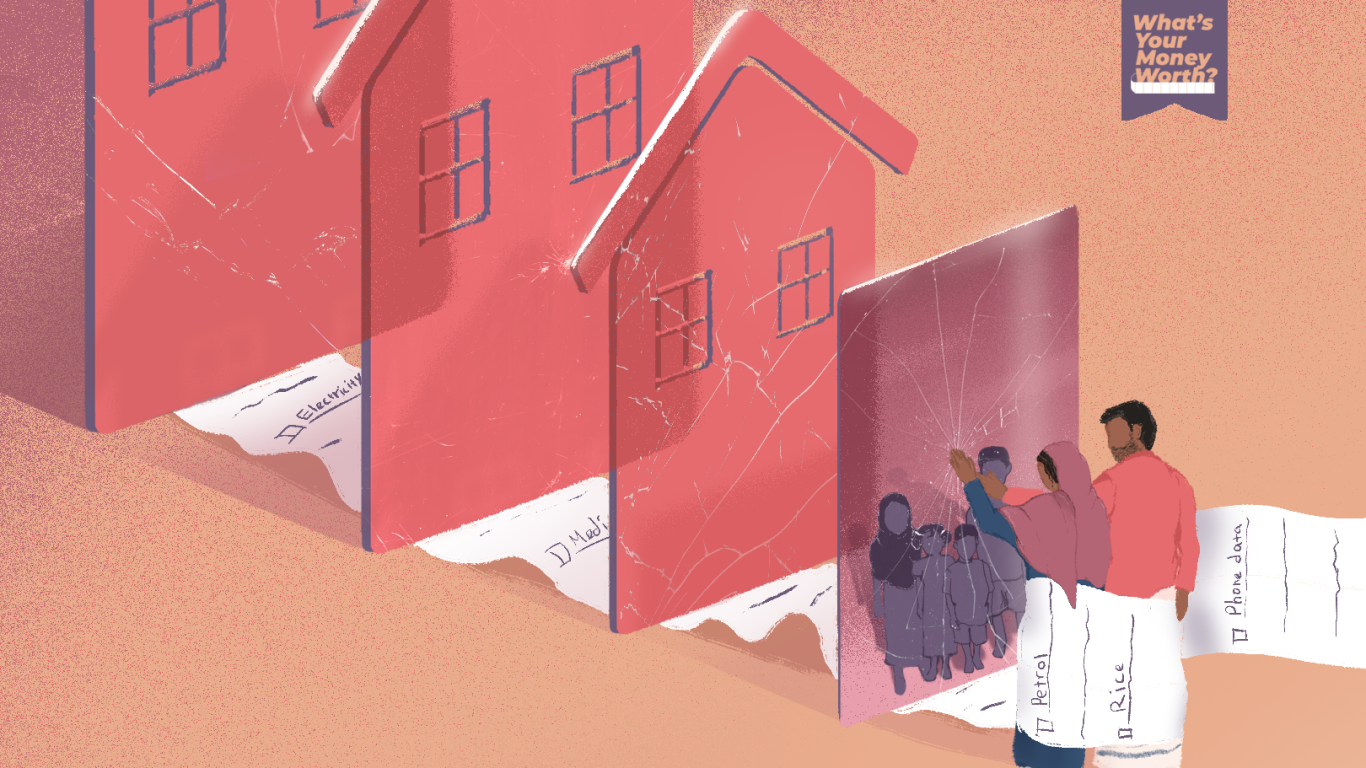
What’s your money worth? A new series from the front line of the cost-of-living crisis, where people who have been hit hard share their monthly expenses.
Names: Mohamed Rizwie (husband) & Fathima Maryam (wife)
Ages: 41 & 39
Occupations: Taxi driver & former domestic worker (now unemployed)
Live with: Their four children: sons Abdul Razzak (8) and Abdur Rahman (3), and daughters Eeman (6) and Sarah (1)
Live in: A 50.5sq m (544sq ft) house down a narrow street in Narahenpita, a suburb of Colombo, the capital of Sri Lanka.
Monthly household income: 25,850 Sri Lankan rupees ($70) [Minimum monthly income needed by a family in Colombo - $201, according to Sri Lanka’s department of census and statistics]
Total expenses for the month: 31,629 Sri Lankan rupees ($86)

After putting the children to bed at around 9pm, Maryam waits for her husband Rizwie to return home from work, whispering a prayer to God to ease their troubles. Sri Lanka’s economic crisis has forced Rizwie, a taxi driver, to work longer hours to feed their family of six. It will be 1am when he finally returns home after nearly 13 hours of work.
Sri Lankans have been through tumultuous times this year. High inflation induced by a worsening economic crisis has caused the cost of living to rise rapidly. The rocketing price of goods stoked mass protests, which led to the ousting of the president in July, but even under a new government inflation continues to hit record highs.
The dire economic reality leaves working-class families like the Rizwies among those worst affected.
Maryam sometimes sheds a tear, worrying about what seems to be an uncertain and bleak future for her children. The clock is ticking, and she knows she is running out of time. In less than a month, she and Rizwie will need to have saved 20,000 Sri Lankan rupees ($54) to settle the monthly rent for their small home, located along a narrow street in Colombo.
But that is a daunting task.
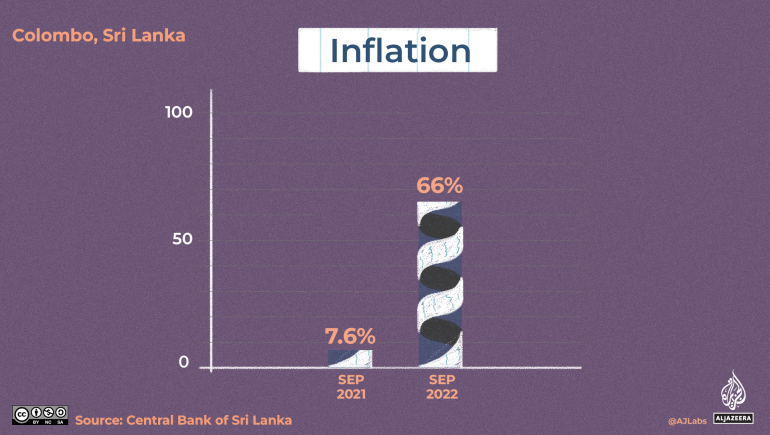
The rent is approximately 80 percent of their monthly income, and the couple cannot imagine how they might manage to save such an amount. Although they were due to pay rent at the beginning of the month, their landlord has offered them a four-week moratorium, having understood the family’s plight.
A five-member family in Colombo would need 74,270 Sri Lankan rupees ($201) to fulfil basic needs for a month, according to Sri Lanka’s Department of Census and Statistics. However, Rizwie - the family’s sole breadwinner - earns just 25,850 Sri Lankan rupees ($70), ferrying customers around the capital and its suburbs in his metered, three-wheeler taxi he purchased many years ago.
Last year, Maryam earned a monthly income of 36,000 Sri Lankan rupees ($97) at her job as a domestic worker. At that time, Rizwie’s income from driving his taxi was a “bonus” to the family’s finances, she says. But Maryam was forced to quit her job in May 2022 following medical advice, after her blood pressure had gone up excessively, causing her body to swell and her arms to be temporarily paralysed. “I felt like the world was crashing upon me, because what I used to earn was the main income for my family,” Maryam recalls.
Now, Maryam and the four children depend on Rizwie’s daily income of about 1,200 Sri Lankan rupees ($3) to survive. In October, with the cost of goods skyrocketing, they were not able to save a single rupee to pay the rent. The family’s expenses exceeded their monthly income, forcing Maryam to seek financial help from her mother to cover their costs.

Streaks of sunlight brighten the cream-painted living room of the family's 50.5sq m (544sq ft) home. At each end of the room is a small study table for the children. On the right, there is a sewing machine and a sofa. On the left, is a six-seater dining table, although nowadays, the family eats their meals while sitting on a mat as the table is broken and they cannot afford to fix it. A radio - one of the few electric appliances in the home, donated to them by Maryam’s former employer - sits on the table but remains switched off to cut down on electricity costs.
In the family’s only bedroom, a fluorescent bulb illuminates the bed on which the children sleep. Their parents sleep on the floor beside it.
Over the course of October 2022, Rizwie and Maryam tracked the family's monthly expenses in collaboration with reporter Hassaan Shazuli.
Here are the expenses that tested her family's finances the most.
The family's expenses over one month
Fuel
Rizwie has to run more taxi rides to earn a higher income. But this means using more fuel. Because the price of petrol in the South Asian island nation has gone up by 109 percent in 12 months, this additional cost has severely crippled his chances of running more trips, or extended trips, to earn more money.
“Last year I could pump about four litres of petrol daily. But now I can only afford to pump a litre. The best I can afford is two litres - that, too, on certain days,” he says.
On days when he runs out of petrol, Rizwie stops work early and returns home, sometimes having to push his three-wheeler for a couple of kilometres (1.2 miles). One night, he buys some petrol from his uncle on credit, promising to pay for it the next day.
Last year, Rizwie would earn about 1,500 rupees ($4) daily by running trips in the evenings after Maryam returned from work. But now, it takes him the whole day to earn this amount. “People don’t use taxis as much as they used to do because transport costs have gone up. We can’t offer rides for low prices either,” Rizwie adds.
Last year: 177 Sri Lankan rupees* ($0.47) for a litre of petrol
This year: 370 Sri Lankan rupees ($1)
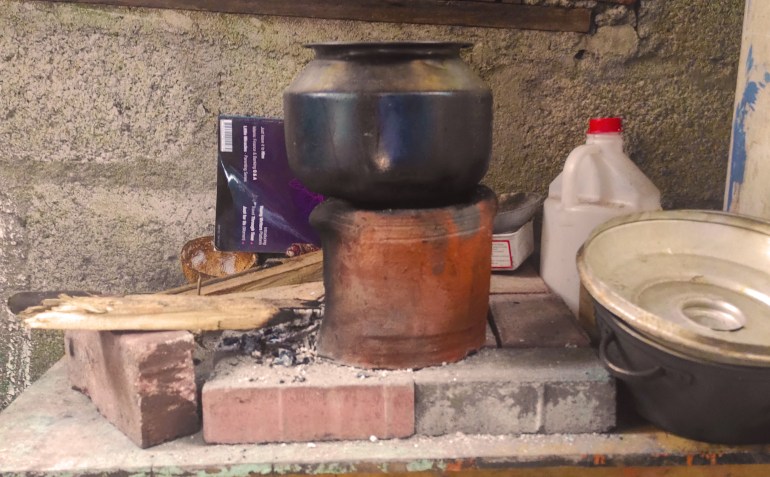
Groceries
Before the cost-of-living crisis hit home, Maryam used to buy rice, sugar, milk powder and other food items like canned fish in bulk, to last for a month. Usually, each family member would have a plateful of rice, two freshly cooked vegetables, and chicken or fish, for breakfast and lunch. For dinner, it was mostly bread or roti (a round flatbread) and some gravy.
But overall food prices have gone up by 85.8 percent in Sri Lanka, forcing the family to adapt to a drastic change in their diet. Maryam can no longer afford to buy groceries in bulk. “We buy leftover vegetables that are about to be discarded just before shops close for the day since they are cheaper,” she says. Instead of having a plate each, the family now eats from a sawan (a large silver plate) to feel they have had enough food. “While eating on the sawan we give our kids more food, and eat less,” Maryam says.
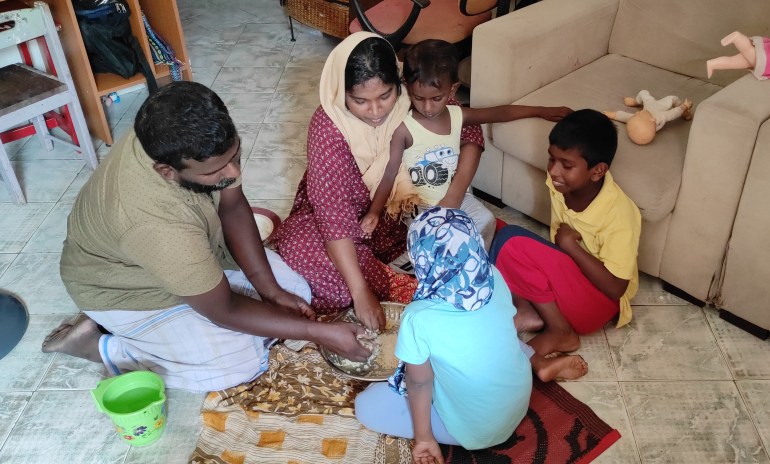
The family is a testament to Sri Lanka’s worsening food crisis. An estimated 7.6 million people in Sri Lanka have an inadequate diet, exposing them to the risk of malnutrition, according to the World Food Programme of the United Nations.
Meat is now a luxury that is entirely off the menu as the family eats rice and vegetables three times a day. “My children cry saying they are fed up with eating the same meal always. But what am I to do? I have to manage with what we have,” Maryam says with pain in her voice. Sometimes, Rizwie manages to buy a couple of eggs, which they give to the children. On other days, the parents go hungry so that their children have more to eat.
Last year, Maryam could prepare meals with ease using a cooking gas cylinder; today, she spends long hours near a firewood stove at the back of the house.
Cooking gas which was 2,750 Sri Lankan rupees ($7.43) last year, is now 4,280 Sri Lankan rupees ($11.57). “We can’t afford to buy cooking gas anymore,” Maryam says. The last gas cylinder that they purchased now lies in their kitchen, empty.
Last year: 412 Sri Lankan rupees* ($1) for a kilogramme of rice, potatoes, and three eggs
This year: 775 Sri Lankan rupees ($2)

Medicine
Maryam is supposed to take two capsules daily to treat her high blood pressure, but the economic crisis has caused medicine prices to go up by 40 percent, and she cannot afford the medication she needs.
Depending on what Rizwie is able to earn, she either opts for one capsule daily or goes without for several days despite being well aware of the associated health risks, including her arms being immobilised. On some days, she buys a few capsules and gives some to her mother, who also has high blood pressure.
Maryam admits that not taking proper medication causes her blood pressure to rise, making her feel weak as a result. When it gets especially bad and her arms don’t function, she is left with no option but to rest for the entire day without doing any household chores. On days like that, her husband stays at home to cook, spend time with the children and feed the little ones.
“When something like that happens, I take medicines regularly until I recover. But I can’t always do that as it becomes unaffordable,” Maryam says.
Last year: 809 Sri Lankan rupees* ($2) for 60 capsules
This year: 1,461 Sri Lankan rupees ($4)
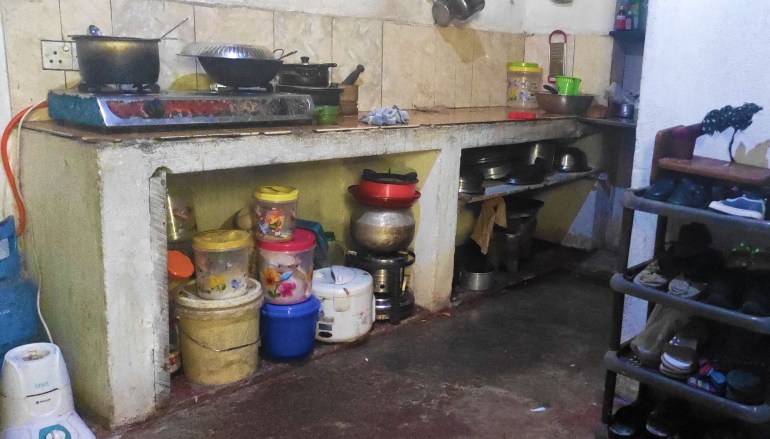
Electricity bills
In August, the government hiked electricity tariffs by 75 percent, placing a severe strain on the expenses of many families. Maryam says her family used to pay a tariff of 1,000 Sri Lankan rupees ($2.70) last year. But now it has gone up to 2,400 Sri Lankan rupees ($6.48).
Last month, the Ceylon Electricity Board delivered a red notice - a warning that they will cut off the electricity supply to their home if the arrears payments are not made. To avert such a situation, Maryam had to ask her mother to pay last month’s bill for them.
To reduce electricity consumption, Maryam has stopped using a washing machine, and has instead resorted to doing the laundry by hand. The fridge and radio also remain turned off. The only electric appliances at home are a fan and a couple of lights.
“If the electricity bill is still high, we will have to go to my mother’s place on some days. But we don’t want to do that, as we will become a burden to them,” she says.
Last year: 1,000 Sri Lankan rupees* ($2.70) for monthly tariffs
This year: 2,400 Sri Lankan rupees ($6.48)

Telecommunication charges
Last year, Maryam and Rizwie both used to top up their phones with a monthly package to use mobile internet services. However, after telecommunication charges were hiked by 20 percent in September 2022, only Maryam’s phone has been topped up.
She only uses data services to make WhatsApp calls and to access the children’s school’s WhatsApp group, on which the teacher uploads activities like homework, or communicates important information.
“There are days when I don’t send my kids to school if they have not been able to access their homework, when we don’t top up my phone. But I make sure it doesn’t always happen,” Maryam says. “We will somehow provide them with the facilities they need to study.”
She stresses that education is the only thing that they provide for the children with few interruptions, as it is vital for their progress.
Last year: 360 Sri Lankan rupees* ($0.97) for a data services package
This year: 460 Sri Lankan rupees ($1.20)
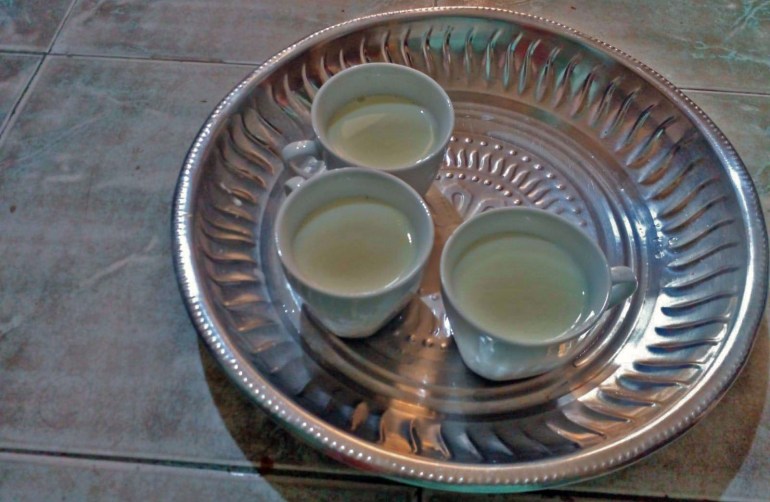
Five quick questions for Rizwie and Maryam:
1. What’s the hardest financial decision you had to make this month? Not buying milk for our kids on certain days. Usually, we would get three of our kids a packet of milk each. But now, we cannot afford it every day, and our kids cry for it. We buy a 180-millilitre packet of milk and mix it with water to increase the quantity.
2. Which is the most worthwhile expense from the month? Nothing can match the happiness of seeing our kids receiving some food that they like. Sometimes, we buy them some toffees and a packet of biscuits which the kids enjoy eating. However, that too is expensive.
3. When finances get tough, what advice do you have? If you can’t pay for something, do not obtain a loan to meet that particular need. Getting into debt means getting into serious trouble that can destroy your entire family and their reputation. It is always better to manage with what you have.
4. What’s your biggest money worry? Not being able to pay the rent. The landlord is asking us to settle the rent for six months at once since he is facing economic hardships as well. But paying such an amount is beyond imaginable and we will be left without a home. We are struggling to save the rent for one month.
5. What’s the saving hack you are proud of? Honestly, we have not been able to save much. Last year, we parents would consume milk tea because we could afford it. Now we have shifted to drinking plain tea so that the milk could be given to our kids. We are proud of the sacrifice we have made.
*Last year’s prices were sourced from Sri Lanka’s Department of Census and Statistics.
Read more stories from the series: What's your money worth?
